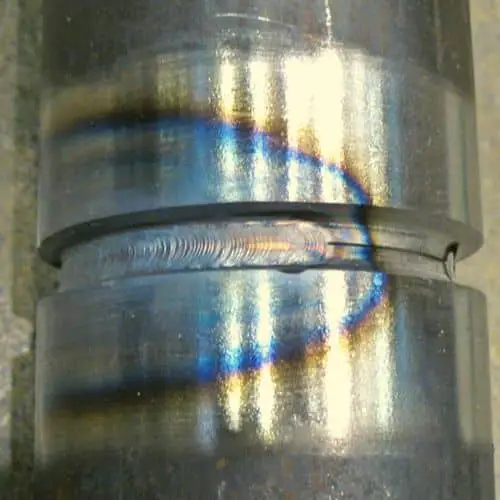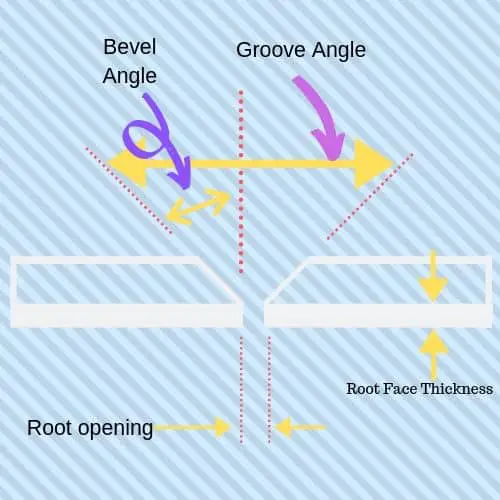
All welding machines have a limit in the material thickness that it can handle in a single pass. And although excessively thick materials are typically more of an issue for the pro welders, hobbyists can also run into similar situations.
In this case, beveling is the solution.
Bevel in welding is an angled flat surface at the end of the material. This opening made by gives the welder access to the total thickness of the material wall and allows him to create a uniform weld using multiple passes which guarantees the mechanical properties of the materials.
A root pass is also created at bevel’s base, forming a place for filling the groove angle created by the 2 bevels by consecutive welding passes.
When And Why You Need To Bevel Your Base Metals
Contents
First, what is groove weld?
A weld groove is defined as the channel in a workpiece surface or an opening in between 2 pieces of base metals that make it possible to penetrate the whole piece, thus creating a strong weld.
So, when to use bevel (groove) in welding?
Grooving or beveling is especially used in butt joints that are thicker than 5/8 inches. However, it can also sometimes be used for materials as thin as ¼ inches where it can assist when working with 110-volt welders.
But why do you need to bevel your base material?
Grinding a bevel on the edges of 2 pieces of material to be joined with welding can effectively reduce the initial thickness that the welding machine must penetrate the puddle. These sides allow for a good initial weld to be placed before adding more bead on top to fill in the remaining joint.
Now, with the bevel filled entirely with good welds, you can confidently grind its joint flat without compromising its strength. In addition, a bevel ensures that you have full penetration.
And although some may suggest to weld thick joints from both sides, it is much easier to access a joint weld from its top surface. Beveling allows you to do the entire operation from a single position. It is used a lot in pipe welding, where you can not weld the metal from both sides.
The Different Types Groove Angles In Welding Depending on Material Thickness
- 3 ≤ T ≤ 20MM (0.787”)
When welders can only access a single side of the joint, preparing with open square edges doesn’t allow the weld metal to completely penetrate materials with a thickness of more than 3mm.
Thus, beveling is required so that the welder can create a root pass at the joint’s bottom, which will be filled by additional passes.
The usual angles for a V grooves are 75 and 60 degrees, depending on the standards applied. However, “J” groove preparations are more often used for this range of thickness.
- 20MM (0.787”) ≤ T
When the wall thickness increase on the parts to be welded, the amount of filler metal needed to be placed in the bead also increases. In order to avoid welding operations that are too costly and too time-consuming from a labor point of view, preparations for welding joints with over 20mm thickness are made using bevels which allow the reduction of the total volume of the bevel.
- COMPOUND V GROOVES OR DOUBLE ANGLE V GROOVES
The primary solution for bevel size reduction is to create a change in your groove angle. The first angle of 30 or 37.5 degrees up to 45 degrees is combined with a second angle between 5 and 15 degrees.
The first angle needs to be kept in order to avoid the groove from becoming too narrow and stopping the welder from making a root pass.
Like the single V grooves, a compound V groove needs to be from 0.5 – 1.5 mm wide and an opening between the parts from 0.5 – 1 mm.
- DOUBLE AND SINGLE ANGLE J GROOVES
The second solution to reduce the bevel volume and the filler metal is the “J” groove preparation. The single angle “J” groove is comprised of angle which is between 5 and 20 degrees.
In the case of really thick walls, double angle “J” groves should be made. In general, the first angle is 20 degrees while the second is at 5 degrees. Both J and compound J groves are typically welded with either zero to a very small opening between the parts.
Considerations When Beveling

There are various ways to bevel— flame-cutting, hand grinding, and machining. When choosing a method to bevel, there are certain factors that you need to consider.
- Shape Configuration
Some of the common bevel symbols used to describe and identify the shaped welding joint configurations in welding specifications are Y, K, V, and double V. The shape of the surface to be welded is not always a flat, straight plate. In some cases, the bevel might need to be put on around or a curved surface. Thus, shape configuration is required as part of normal operating procedure when several pieces of metal are to be welded together.
- Angle Degree
Various angles apply to various applications. In most cases of beveling pipe, the standard bevel is about 37. Degree. However, this is not the case for other metal applications.
Remember that whatever degree, being able to keep that angle within tolerance level is critical for a good bevel.
- Bevel Length
Another thing to achieve a good bevel is the length. This is the length of the material removed in order to allow the weld bead to be laid.
In general, it is measured by the hypotenuse of the angle. Remember to have consistent bevel length since it ensures an easier and quicker operation when the welding is done. The more consistent bevel serves to reinforce the weld and makes it stronger since the structure of the base metal remains the same throughout the pieces welded together.
Conclusion
I hope that this post was helpful to you to figure out what is groove and bevel. It sure can come handy even with home projects. If you are a beginner and using a smaller welder, using bevel you can take on bigger projects. As far as the methods to grind bevels, as a hobbyist, it is reasonable to use an angle grinder or a bench grinder if you have one.
